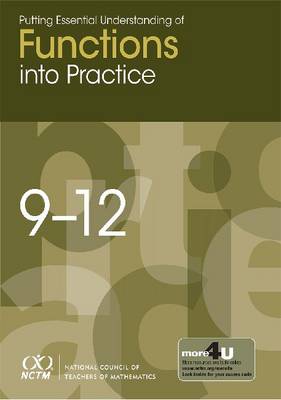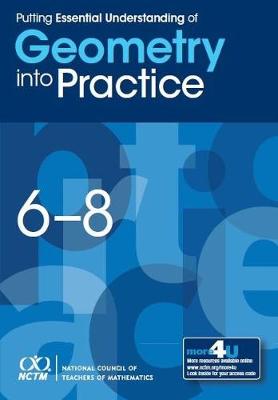Putting Essential Understanding into Practice
3 total works
Putting Essential Understanding of Functions into Practice in Grades 9-12
by Robert Ronau, Dan Meyer, and Terry Crites
Published 1 November 2013
Do your students think that the vertical line test is indispensable and foolproof for determining whether a relationship is a function? Do they believe that every function can be modeled by an equation? Do they interpret the graph of a function as the function itself?
What tasks can you offer - what questions can you ask - to determine what they know or don't know - and move them forward in their thinking?
This book focuses on the specialized pedagogical content knowledge that you need to teach functions effectively in grades 9-12. The authors demonstrate how to use this multifaceted knowledge to address the big ideas and essential understandings that students must develop for success with functions - not only in their current work, but also in higher-level mathematics and a myriad of real-world contexts.
Explore rich, research-based strategies and tasks that show how students are reasoning about and making sense of functions. Use the opportunities that these and similar tasks provide to build on their understanding while identifying and correcting misunderstandings that may be keeping them from taking the next steps in learning.
You have essential understanding. It's time to put it into practice in your teaching.
The Putting Essential Understanding into Practice Series moves NCTM's Essential Understanding Series into the classroom. The new series details and explores best practices for teaching the essential ideas that students must grasp about fundamental topics in mathematics - topics that are challenging to learn and teach but are critical to the development of mathematical understanding. Classroom vignettes and samples of student work bring each topic to life, and questions for reader reflection open it up for hands-on exploration. Each volume underscores connections with the Common Core State Standards for Mathematics while highlighting the knowledge of learners, curriculum, instructional strategies, and assessment that pedagogical content knowledge entails. Resources and tasks are available at nctm.org/more4U.
Maximize the potential of student-centered learning and teaching by putting essential understanding into practice.
What tasks can you offer - what questions can you ask - to determine what they know or don't know - and move them forward in their thinking?
This book focuses on the specialized pedagogical content knowledge that you need to teach functions effectively in grades 9-12. The authors demonstrate how to use this multifaceted knowledge to address the big ideas and essential understandings that students must develop for success with functions - not only in their current work, but also in higher-level mathematics and a myriad of real-world contexts.
Explore rich, research-based strategies and tasks that show how students are reasoning about and making sense of functions. Use the opportunities that these and similar tasks provide to build on their understanding while identifying and correcting misunderstandings that may be keeping them from taking the next steps in learning.
You have essential understanding. It's time to put it into practice in your teaching.
The Putting Essential Understanding into Practice Series moves NCTM's Essential Understanding Series into the classroom. The new series details and explores best practices for teaching the essential ideas that students must grasp about fundamental topics in mathematics - topics that are challenging to learn and teach but are critical to the development of mathematical understanding. Classroom vignettes and samples of student work bring each topic to life, and questions for reader reflection open it up for hands-on exploration. Each volume underscores connections with the Common Core State Standards for Mathematics while highlighting the knowledge of learners, curriculum, instructional strategies, and assessment that pedagogical content knowledge entails. Resources and tasks are available at nctm.org/more4U.
Maximize the potential of student-centered learning and teaching by putting essential understanding into practice.
Putting Essential Understanding of Geometry into Practice in Grades 6-8
by Terry Crites, Barbara J Dougherty, Hannah Slovin, and Karen Karp
Published 1 December 2017
Do your students suppose that if the perimeter of a shape increases, the area also increases? Do they think that area is the product of base and height, without understanding that this applies only to parallelograms? Do they believe that a transformation happens only on or to a particular object and not the entire plane?
What tasks can you offer-what questions can you ask-to determine what they know or don't know-and move them forward in their thinking?
This book focuses on the specialized pedagogical content knowledge that you need to teach geometry effectively in grades 6-8. The authors demonstrate how to use this multifaceted knowledge to address the big ideas and essential understandings that students must develop for success with geometry-not only in their current work, but also in higher-level mathematics and a myriad of real-world contexts.
Explore rich, research-based strategies and tasks that show how students are reasoning about and making sense of geometry. Use the opportunities that these and similar tasks provide to build on their understanding while identifying and correcting misunderstandings that may be keeping them from taking the next steps in learning.
What tasks can you offer-what questions can you ask-to determine what they know or don't know-and move them forward in their thinking?
This book focuses on the specialized pedagogical content knowledge that you need to teach geometry effectively in grades 6-8. The authors demonstrate how to use this multifaceted knowledge to address the big ideas and essential understandings that students must develop for success with geometry-not only in their current work, but also in higher-level mathematics and a myriad of real-world contexts.
Explore rich, research-based strategies and tasks that show how students are reasoning about and making sense of geometry. Use the opportunities that these and similar tasks provide to build on their understanding while identifying and correcting misunderstandings that may be keeping them from taking the next steps in learning.
This book, the eleventh in the Putting Essential Understanding into Practice Series, focuses on misconceptions about variables, expressions, equations, and functions that students often bring to grades 6-8. The authors present tasks given to middle-grades students and examine sample responses to them to show how teachers can bring misconceptions to the surface, where they and their students can inspect them, recognize errors and limitations, and replace faulty thinking with robust ideas.


